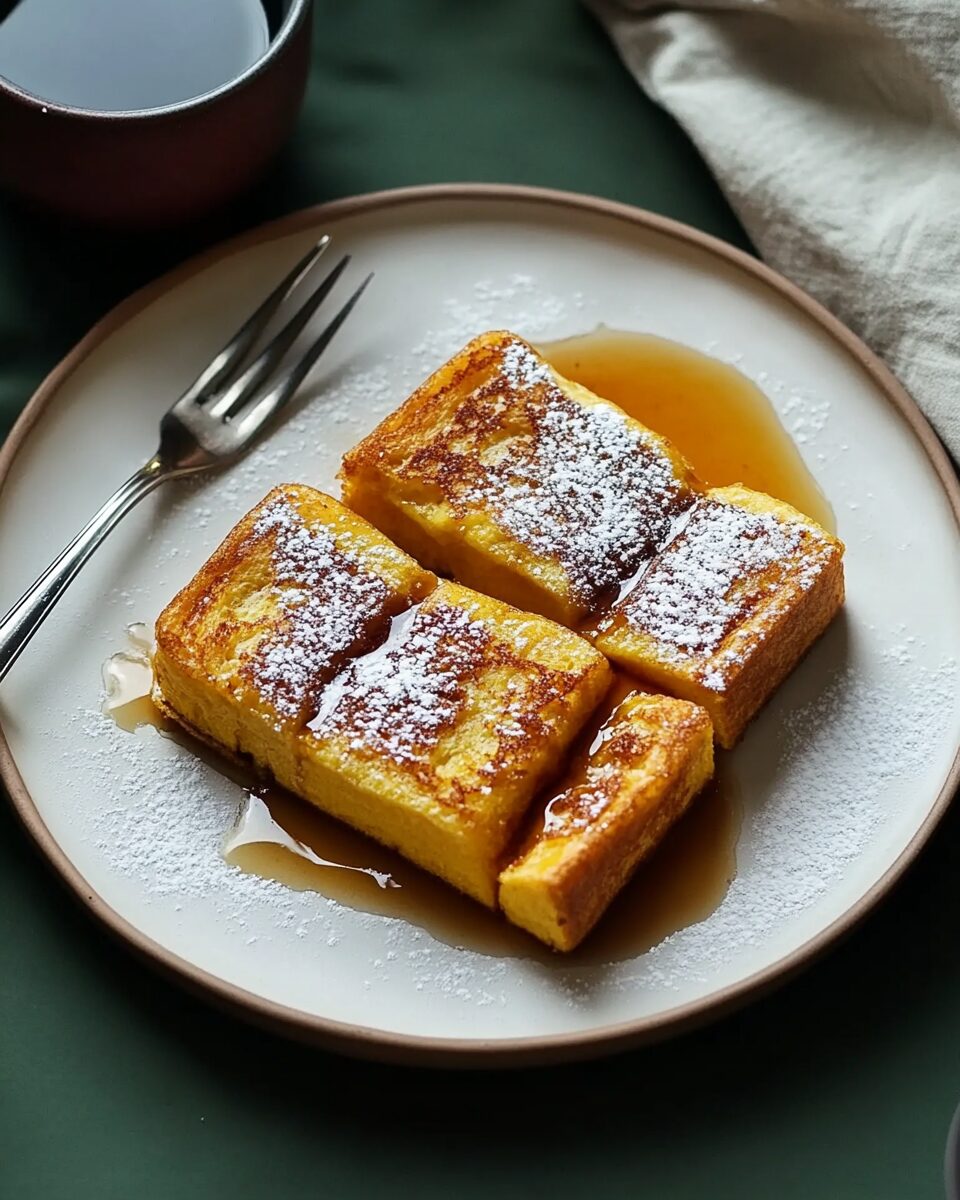This Japanese-style Tamagoyaki French Toast is a delightful fusion of traditional French toast and the sweet-savory flavors of tamagoyaki, a Japanese rolled omelette. Featuring thick slices of shokupan (Japanese milk bread) soaked in a rich custard mixture of eggs, cream, soy sauce, and mirin, this dish is cooked slowly to achieve a soft, custardy interior and a lightly crisp exterior.
Full Recipe:
Ingredients
- 2 slices thick-cut bread (preferably shokupan)
- 2 large eggs
- 1/4 cup cream
- 1 tablespoon sugar
- 1 tablespoon low-sodium soy sauce
- 1 tablespoon mirin
- Oil for the pan
To Serve:
- Whipped cream
- Maple syrup
- Powdered sugar
Directions
- Trim the crusts off the bread slices and set aside.
- In a liquid measuring cup, whisk together the eggs, cream, sugar, soy sauce, and mirin. For an extra smooth texture, strain the mixture.
- Divide the egg mixture equally between two shallow bowls. Place one slice of bread in each bowl, ensuring they are fully submerged. Cover and refrigerate for 1–2 hours. Gently flip the bread slices and soak for an additional 1–2 hours.
- When ready to cook, heat a non-stick pan over very low heat and add a touch of oil. Let the excess custard drip off the bread slices, then place them in the pan. Cover and cook for 8–10 minutes until the bottom is slightly golden. Carefully flip the slices, cover, and cook for another 8–10 minutes until the other side is golden and the toast is puffy.
- Serve hot, topped with whipped cream, maple syrup, and powdered sugar if desired.
Nutritional Facts (Per Serving, Approximate)
- Calories: 320
- Total Fat: 20g
- Saturated Fat: 8g
- Cholesterol: 190mg
- Sodium: 420mg
- Total Carbohydrates: 25g
- Dietary Fiber: 1g
- Sugars: 8g
- Protein: 10g
The Origins of Tamagoyaki
Tamagoyaki, the key ingredient in this recipe, has a long history in Japanese cuisine. Often referred to as a Japanese omelette, it is a dish made by cooking thin layers of egg in a rectangular pan, rolling them into a cylindrical shape. The key to making a perfect tamagoyaki lies in the balance of ingredients such as eggs, sugar, soy sauce, and mirin, which gives the omelette a slightly sweet and savory flavor profile. It’s often served in bento boxes, sushi rolls, or simply as a standalone dish.
The word “tamagoyaki” translates to “grilled egg,” and the cooking process involves rolling and layering eggs over low heat, which results in a tender, delicate texture. The unique combination of savory and slightly sweet flavors has made tamagoyaki a staple of Japanese breakfast and lunch menus.
While tamagoyaki is generally associated with Japanese cuisine, it has influenced other cooking styles, and creative variations, such as Tamagoyaki French Toast, are proof of its versatility. The marriage of French toast with the Japanese omelette not only showcases the best of both culinary traditions but also introduces new textures and flavors to a familiar comfort food.
The Concept of Tamagoyaki French Toast
Tamagoyaki French Toast takes the concept of the traditional French toast and elevates it by infusing it with the savory-sweet flavor of tamagoyaki. The bread is soaked in a rich custard mixture made from eggs, heavy cream, soy sauce, and mirin. The tamagoyaki-inspired custard creates a fluffy, custardy interior once cooked, unlike traditional French toast, which typically has a more spongy and dry texture. By using shokupan bread, which is known for its soft and airy texture, the French toast becomes even more decadent and smooth.
This fusion dish is cooked slowly over low heat to ensure the custard has time to set and create the perfect texture. The result is a French toast that is crispy on the outside with a melt-in-your-mouth softness on the inside, thanks to the tamagoyaki influence.
The Role of Shokupan in Tamagoyaki French Toast
Shokupan, a type of Japanese milk bread, plays an important role in the creation of Tamagoyaki French Toast. This bread is different from regular French bread because of its light, fluffy texture, which makes it perfect for absorbing the rich custard mixture without becoming soggy. Shokupan is slightly sweet and moist, adding to the indulgent experience of eating French toast.
The bread’s pillowy softness ensures that the French toast retains its lightness, despite the thick custard soak. Its texture allows for the custard to penetrate the bread more evenly, resulting in a balanced consistency that is not overly dense. The soft, slightly sweet flavor of shokupan complements the savory elements of soy sauce and mirin in the custard, creating a perfect contrast that adds depth to the flavor profile of the dish.
Soy Sauce and Mirin: The Japanese Touch
A key feature that sets Tamagoyaki French Toast apart from traditional French toast is the use of soy sauce and mirin. These two ingredients, staples in Japanese cooking, bring a delicate balance of sweetness and umami to the dish. Soy sauce is a fermented condiment that adds saltiness and depth, while mirin, a sweet rice wine, contributes a mild sweetness that balances the savory elements of the dish.
In Tamagoyaki French Toast, the soy sauce and mirin not only help create the custard for soaking the bread but also infuse the dish with an additional layer of flavor. The savory and slightly sweet combination enhances the richness of the French toast and complements the bread’s subtle sweetness, giving the dish a unique twist compared to its Western counterpart.
Cooking Techniques for Perfect Tamagoyaki French Toast
To achieve the perfect Tamagoyaki French Toast, it’s important to cook the dish slowly and carefully. Since the custard is thicker and richer than typical French toast mixtures, it requires a slower cooking time to ensure it cooks through without burning or becoming too crisp on the outside. Cooking the toast on low heat for a longer period allows the custard to set inside while creating a beautifully golden crust on the outside.
The key to success with this recipe is ensuring that the custard soaks into the bread without making it too soggy. This can be achieved by letting the bread rest in the custard mixture for a couple of hours, allowing the liquid to soak in evenly without becoming too wet. The bread should retain some structure but also absorb enough of the custard to provide a rich and soft center once cooked.
Serving Suggestions for Tamagoyaki French Toast
Tamagoyaki French Toast is perfect for breakfast, brunch, or even a special dessert. Its versatility means it can be paired with a variety of toppings and side dishes to elevate the experience. Common accompaniments include whipped cream, maple syrup, and powdered sugar, which enhance the sweetness of the dish. For a savory twist, you can also pair it with pickled vegetables, a drizzle of extra soy sauce, or even a sprinkle of fresh herbs.
Tamagoyaki French Toast can be served as an indulgent weekend breakfast or as part of a larger brunch spread. Its rich flavors make it a show-stopping dish for any occasion, and it pairs well with a cup of freshly brewed coffee, matcha, or a light fruit salad. The combination of sweet and savory makes it a dish that appeals to a wide range of palates, from those who prefer a sweeter breakfast to those who enjoy more umami-rich flavors.
Health Considerations and Nutritional Benefits
While Tamagoyaki French Toast is undeniably indulgent, it’s important to consider its nutritional profile. The dish provides a good source of protein from the eggs and the bread, with the richness of the cream adding some healthy fats. However, as with many decadent breakfast options, it’s important to enjoy this dish in moderation, particularly if you are watching your calorie intake.
Conclusion
Tamagoyaki French Toast is an innovative and delicious fusion dish that brings together the best of Japanese and Western cuisines. The combination of rich, custardy French toast and the savory-sweet elements of tamagoyaki creates a unique and satisfying breakfast or brunch dish. By using shokupan bread, soy sauce, and mirin, this dish offers a depth of flavor and texture that sets it apart from traditional French toast.






